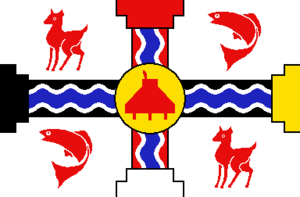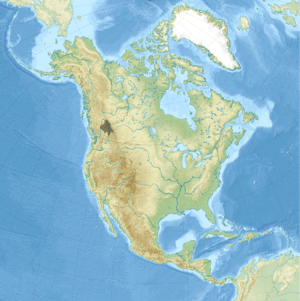Secwépemc facts for kids
| Secwépemc | |
|---|---|
 |
|

Location and extent of Secwepemcúĺecw
|
|
| Total population | |
| 6,755 (Including those of mixed ancestry) (2016) | |
| Regions with significant populations | |
| Canada (British Columbia) | |
| Languages | |
| Shuswap, English | |
| Related ethnic groups | |
| other Salish |
The Secwépemc (say "shə-WHEP-əm"), also known as the Shuswap people, are a First Nations group in British Columbia, Canada. They live in the central part of the province. Their language, called Secwepemctsín, is part of the Salishan languages family.
Their traditional land, known as Secwepemcúĺecw, is very large. It stretches across different areas, including plateaus, rivers, and mountains. This territory covers about 145,000 square kilometers. For a long time, the Secwepemc people lived by hunting, fishing, and trading goods. These activities were very important for their communities.
Contents
Understanding Secwepemc History and Culture
The Secwepemc people have a rich history and culture. Their language, Secwepemctsín, is a key part of their identity. It is one of the most spoken Salishan languages in British Columbia.
How the Secwepemc Language is Being Kept Alive
More than 1,600 people speak Secwepemctsín today. The Secwepemc Nation is working hard to keep their language strong. For example, Chief Atahm School teaches the language to students from kindergarten to grade nine. They use an immersion program, which means students learn mostly in Secwepemctsín. Simon Fraser University also offers a program. This program teaches students about the Secwepemc language, culture, and traditions.
Protecting Their Land and Rights
The Secwepemc people have always believed in their right to their land. In 1910, their Chiefs wrote a letter to Prime Minister Laurier. This letter explained their concerns about European-Canadian settlement. These concerns had grown over 50 years. Since the late 1900s, the Secwepemc have created groups to help their people. These include the Shuswap Nation Tribal Council and the Secwepemc Cultural Education Society. These groups work to support their communities and preserve their heritage.
Traditional Secwepemc Communities and Groups
The Secwepemc people were traditionally organized into different groups or divisions. Each group lived in a specific area. Many of these groups still exist today as modern First Nations bands.
- Setlemuk or Canyon Shuswap: They lived west of the Fraser River. Many of them were affected by diseases in the 1800s. Survivors joined the Alkali Lake band (Esketemc).
- Skstellnemuk or Shuswap Lake Division: They lived near the Upper South Thompson River and Shuswap Lake. Today, they are known as the Neskonlith Indian Band.
- Stietamuk or Lake Division: These "interior people" lived between the Fraser and North Thompson rivers. The Canim Lake band (Tsq'escen']) is a surviving group from this division.
- Stkamlulepsemuk or Kamloops Division: These were the people of Kamloops and Savona. The Kamloops band (Stkamluleps) is a well-known group from this area.
- Stlemhulehamuk or Fraser River Division: They lived in the Fraser River valley. This division included groups like the Williams Lake (T'exelc) and Alkali Lake (Esketemc) bands.
- Tekkakalt or North Thompson Division: These were the people of the North Thompson region. The Kinbasket or Kenpésqt group is part of this division. They are now called the Shuswap band Kenpesq't.
- Zaktcinemuk or Bonaparte Division: They lived in the Bonaparte River valley. The Pavilion (Ts'kw'aylaxw First Nation) and Bonaparte River (now Stuctwesecm) bands are examples from this division.
Notable Secwepemc People
Many Secwepemc individuals have made important contributions in various fields.
- Darrell Dennis: A comedian, actor, and radio personality.
- George Manuel: He was a leader who became president of the National Indian Brotherhood. He also helped start the World Council of Indigenous Peoples.
- Vera Manuel: A talented poet and playwright, and George Manuel's daughter.
- Arthur Manuel: A political leader and activist, and George Manuel's son.
- Grace Dove: An actress and television host.
- Tania Willard: A curator and artist.
- Kanahus Manuel: A political activist.
- Bev Sellars: A writer and activist.
See also
 In Spanish: Shuswap para niños
In Spanish: Shuswap para niños

